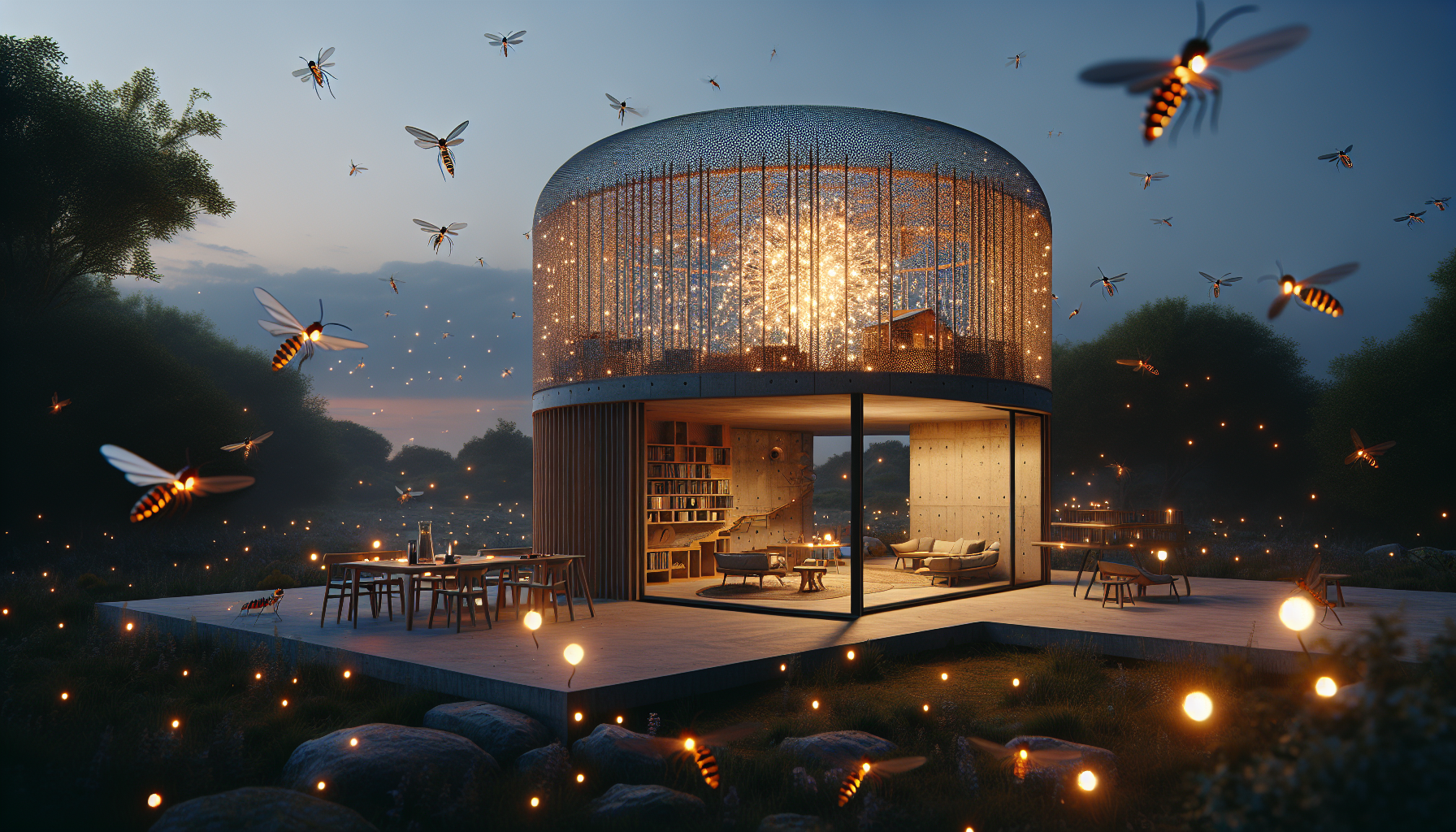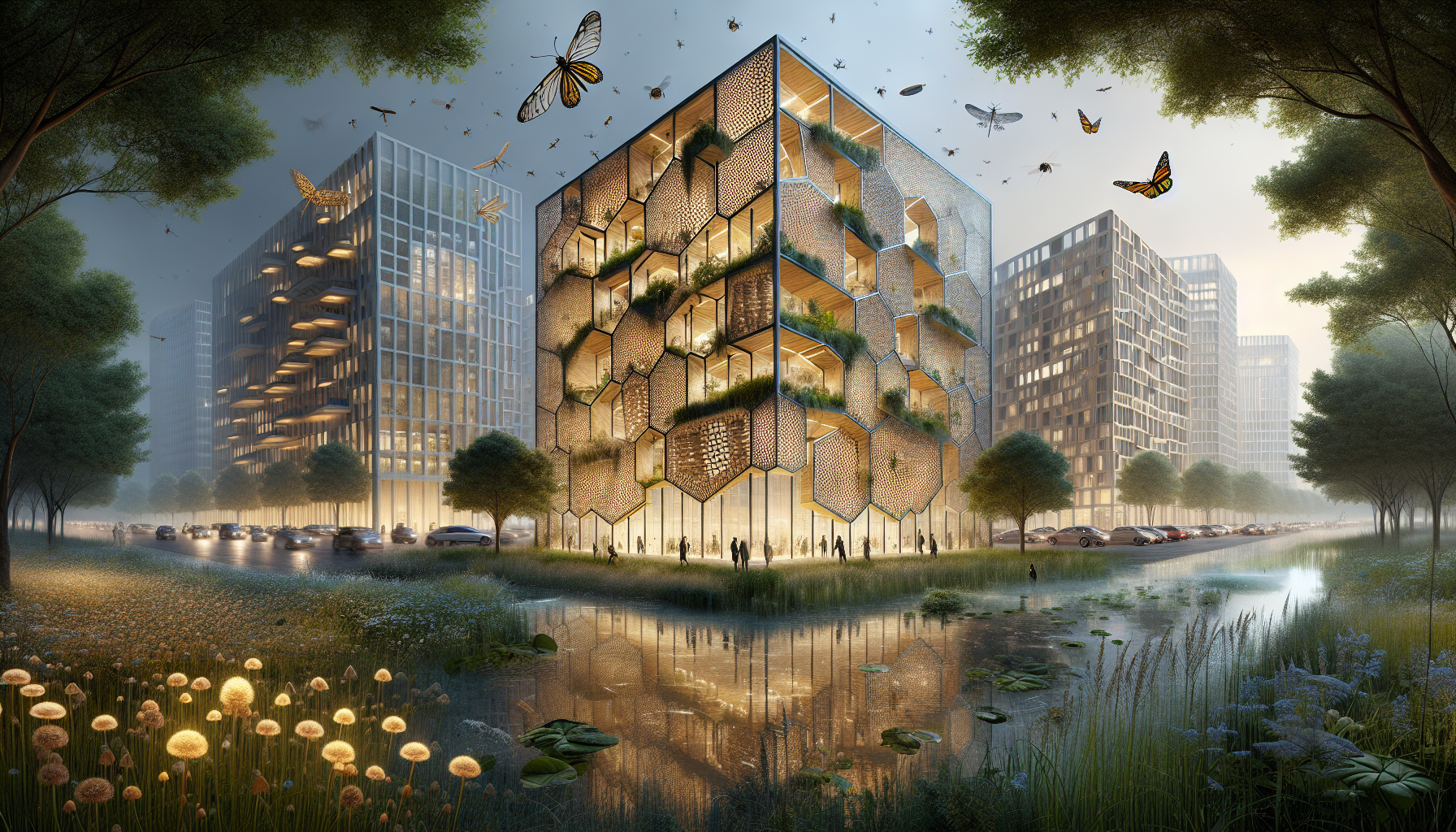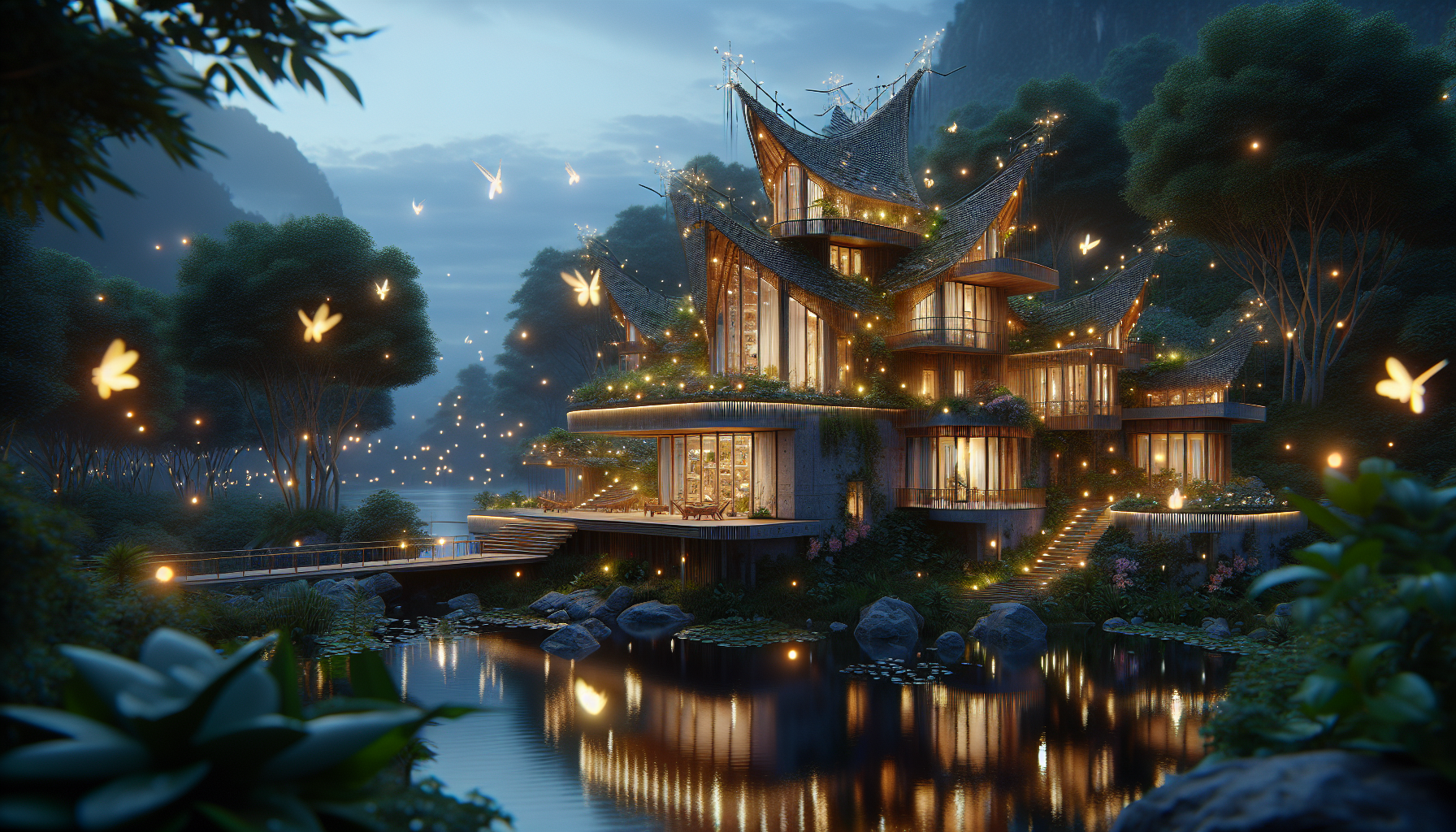In the ever-evolving landscape of sustainable architecture and design, innovation often stems from the most unexpected sources. One such groundbreaking development is the BioLight collection, a revolutionary series of architectural designs inspired by the natural allure of fireflies. This collection uses cutting-edge microstructural technology to attract specific insects, harmoniously integrating the natural world with urban environments. As urbanization continues to encroach upon natural habitats, the BioLight collection offers a glimmer of hope, suggesting a future where human-made structures can coexist with—and even enhance—the ecosystems around them.
The fascination with fireflies is universal, transcending cultures and generations. These enchanting creatures, with their gentle, bioluminescent glow, have captivated humans for centuries. But beyond their beauty lies a functional brilliance—fireflies have evolved complex microstructures that allow them to communicate and attract mates through light. The architects and scientists behind the BioLight collection have meticulously studied these natural phenomena, translating them into innovative architectural features that serve a dual purpose: aesthetic allure and ecological function. This synthesis of form and function raises intriguing questions about how we can design spaces that not only serve human needs but also contribute to ecological balance.
Imagine strolling through a city park at dusk, where the lampposts and buildings emit a soft, inviting glow reminiscent of a firefly’s light. These structures are not only visually striking but also serve as beacons for specific insect species, promoting biodiversity within urban settings. The BioLight collection leverages the power of biomimicry, employing microstructures that mimic the light-emitting capabilities of fireflies. This deliberate design choice is more than mere imitation; it’s an invitation for nature to flourish in tandem with human development. By attracting beneficial insects, these structures can enhance pollination, support food webs, and contribute to healthier urban ecosystems.
This article will delve into the myriad facets of the BioLight collection, exploring its innovative design principles and the scientific research underpinning its development. We’ll examine how the integration of bio-inspired technologies can redefine architectural aesthetics and functionality, fostering environments that are not only visually captivating but also ecologically sustainable. From the initial concept to the practical applications and challenges faced during implementation, we’ll provide a comprehensive overview of this pioneering endeavor. Alongside expert insights and case studies, we’ll explore the potential of the BioLight collection to inspire a new wave of sustainable design practices that prioritize harmony with nature.
As we embark on this exploration of the BioLight collection, prepare to be enlightened by the possibilities of architecture that transcends traditional boundaries. This journey promises to be as illuminating as the fireflies that inspired it, offering fresh perspectives on how we can shape the built environment to benefit both people and the planet. Join us as we uncover the magic of the BioLight collection—a testament to human ingenuity and a hopeful vision for the future of sustainable design.
Introduction to the BioLight Collection
The BioLight Collection represents a groundbreaking approach in architectural design, merging the natural world with cutting-edge technology to create structures that attract specific insect species. This innovative concept, often referred to as “Firefly Architecture,” utilizes microstructures to create environments that cater specifically to the biological and behavioral needs of insects. This fusion of biology and architecture has the potential to revolutionize how we think about urban ecosystems, sustainability, and the role of insects in our daily lives.
In recent years, there has been a growing interest in understanding and integrating natural processes into architectural design. The BioLight Collection stands at the forefront of this movement, offering a unique perspective on how architecture can be used to support biodiversity and ecological balance. The design principles behind this collection are rooted in biomimicry, an approach that seeks to emulate natural systems and processes to solve human challenges. By studying how insects interact with their environments, architects and designers have been able to create structures that not only attract these creatures but also support their life cycles.
Moreover, the implications of the BioLight Collection extend beyond environmental benefits. The presence of specific insect species can enhance the aesthetic and sensory experiences within architectural spaces, providing a unique ambiance that is both dynamic and engaging. This integration of nature and architecture can lead to increased awareness and appreciation of biodiversity, encouraging people to reconsider their relationship with the natural world. As we continue to explore the possibilities of this innovative approach, it’s essential to understand the underlying principles and potential applications of the BioLight Collection.
The Science Behind Firefly Architecture
The concept of Firefly Architecture is deeply rooted in the study of insect behavior and the natural phenomena that influence it. At the heart of this approach is the understanding of how certain microstructures can attract and support specific insect species. These microstructures are designed to mimic natural habitats, providing the right conditions for insects to thrive. This section delves into the scientific principles that underpin the BioLight Collection and explores how these principles are applied in architectural design.
Insects are highly sensitive to environmental cues, such as light, texture, and temperature. The BioLight Collection leverages these sensitivities by incorporating materials and design elements that replicate the natural conditions preferred by certain insect species. For example, researchers have discovered that fireflies are attracted to surfaces with specific reflective properties. By integrating these properties into architectural structures, designers can create environments that draw fireflies and other insects, enhancing the ecological value of the space.
One of the key challenges in developing Firefly Architecture is understanding the complex interactions between insects and their habitats. This requires a multidisciplinary approach, involving expertise in biology, ecology, and material science. Researchers use advanced technologies, such as spectroscopy and micro-imaging, to study the fine details of insect behavior and habitat preferences. This data is then used to inform the design of microstructures that can effectively attract and support insect populations.
The application of these scientific principles is not limited to fireflies. The BioLight Collection aims to support a wide range of insect species, each with its own unique ecological role. By creating environments that cater to the specific needs of these species, architects can promote biodiversity and ecological resilience. This approach also opens up new possibilities for sustainable urban development, where architectural spaces are designed to coexist harmoniously with the natural world.
Design Principles and Techniques
The success of the BioLight Collection lies in its ability to seamlessly integrate design principles with scientific insights. This section explores the various techniques used to create structures that attract and support insect populations, focusing on the materials, shapes, and patterns that define Firefly Architecture.
A key component of the BioLight Collection is the use of bioluminescent materials. These materials emit light through a chemical reaction, mimicking the natural glow of fireflies and other bioluminescent organisms. By incorporating bioluminescence into architectural structures, designers can create environments that not only attract insects but also provide a visually stunning spectacle. This technique is particularly effective in urban settings, where artificial lighting often disrupts natural insect behaviors.
Another important aspect of Firefly Architecture is the use of textured surfaces. Insects rely on tactile cues to navigate their environments, and the BioLight Collection uses micro-textures to enhance these cues. By replicating the textures found in natural habitats, such as the bark of trees or the surface of leaves, designers can create structures that feel familiar to insects. This familiarity encourages insects to interact with the structures, promoting ecological engagement and biodiversity.
In addition to materials and textures, the BioLight Collection also employs innovative design patterns. These patterns are inspired by the natural world and are designed to attract specific insect species. For example, researchers have found that certain geometric patterns are more effective at attracting bees, while others are preferred by butterflies. By incorporating these patterns into architectural designs, the BioLight Collection can support a diverse range of insect populations, each contributing to the ecological health of the area.
Practical Applications and Benefits
The BioLight Collection offers a wide range of practical applications and benefits, both for the environment and for human communities. This section explores how Firefly Architecture can be implemented in various settings and the positive impact it can have on biodiversity, sustainability, and human well-being.
One of the most promising applications of the BioLight Collection is in urban environments. As cities continue to expand, the need for sustainable development solutions has become increasingly urgent. Firefly Architecture provides a way to incorporate natural elements into urban spaces, creating green corridors and habitats for insects within the cityscape. This not only supports biodiversity but also enhances the quality of life for urban residents by providing green spaces and reducing the urban heat island effect.
In addition to urban applications, the BioLight Collection can also be used in agricultural settings. Insects play a crucial role in pollination and pest control, and by creating environments that support beneficial insect species, farmers can improve crop yields and reduce the need for chemical pesticides. This approach aligns with the principles of sustainable agriculture, promoting ecological balance and reducing the environmental impact of farming practices.
Furthermore, the BioLight Collection has the potential to contribute to environmental education and awareness. By incorporating Firefly Architecture into public spaces, such as parks and gardens, communities can engage with the natural world and learn about the importance of insects in ecosystems. This educational aspect can foster a greater appreciation for biodiversity and inspire individuals to take action to protect the environment.
Challenges and Considerations
While the BioLight Collection offers many benefits, there are also challenges and considerations that must be addressed to ensure its success. This section discusses some of the key challenges in implementing Firefly Architecture and the strategies that can be used to overcome them.
One of the main challenges is the need for interdisciplinary collaboration. The development of Firefly Architecture requires expertise in biology, ecology, materials science, and design. Bringing together professionals from these diverse fields can be challenging, but it is essential for creating effective and sustainable architectural solutions. Establishing partnerships between research institutions, design firms, and environmental organizations can facilitate this collaboration and drive innovation.
Another consideration is the potential impact on local ecosystems. While Firefly Architecture is designed to support biodiversity, it is important to ensure that the introduction of new structures does not disrupt existing ecosystems. Careful planning and environmental assessments are needed to evaluate the potential effects of new developments and to ensure that they align with conservation goals.
Finally, there is the challenge of public perception and acceptance. Innovative architectural concepts, such as Firefly Architecture, may be met with skepticism or resistance from the public. Educating communities about the benefits of the BioLight Collection and involving them in the planning process can help to build support and ensure the successful implementation of these projects.
Future Prospects and Innovations
The BioLight Collection represents just the beginning of what is possible with Firefly Architecture. As research continues and technology advances, there are exciting prospects for further innovations in this field. This section explores some of the potential future developments and the ways in which they could shape the built environment.
One area of potential growth is the use of advanced materials in Firefly Architecture. As new materials are developed, there is the possibility of creating structures that are even more effective at attracting and supporting insect populations. For example, researchers are exploring the use of nanomaterials to create surfaces with enhanced optical and tactile properties. These materials could improve the efficiency of bioluminescence and micro-texturing, leading to more vibrant and engaging architectural spaces.
Another promising direction is the integration of technology into Firefly Architecture. The use of sensors and data analytics could provide valuable insights into insect behavior and habitat preferences, allowing for more precise and adaptive architectural designs. Additionally, the incorporation of smart technologies could enable structures to respond dynamically to environmental changes, optimizing conditions for insect populations in real-time.
Finally, there is the potential for expanding the application of Firefly Architecture to new contexts and environments. While the current focus is on urban and agricultural settings, the principles of the BioLight Collection could be applied to a wide range of landscapes, from forests to wetlands. This could open up new opportunities for conservation and restoration efforts, using architecture as a tool to support and enhance natural ecosystems.
Table of Comparative Analysis
Below is a table that compares different aspects of traditional architecture and Firefly Architecture, highlighting the unique features and benefits of the BioLight Collection.
| Aspect | Traditional Architecture | Firefly Architecture |
|---|---|---|
| Design Approach | Focuses on human-centric design, often prioritizing aesthetics and functionality for human use. | Integrates natural processes and ecological principles, creating environments that support biodiversity. |
| Material Use | Utilizes conventional building materials such as concrete, steel, and glass. | Incorporates bioluminescent and textured materials to attract specific insect species. |
| Environmental Impact | Can contribute to urban heat island effect and disrupt local ecosystems. | Promotes biodiversity and ecological balance, reducing environmental impact. |
| Public Perception | Widely accepted and understood by the public. | Innovative concept that may require education and awareness efforts for acceptance. |
| Applications | Primarily used in urban and residential settings. | Applicable in urban, agricultural, and natural environments for conservation and sustainability. |
Conclusion and Call to Action
The exploration of the BioLight Collection and Firefly Architecture reveals a promising intersection of biology and design that can transform our built environments. As we continue to face challenges related to urbanization, biodiversity loss, and climate change, innovative approaches like Firefly Architecture offer a pathway toward more sustainable and harmonious coexistence with the natural world.
We encourage readers to delve deeper into this fascinating topic by exploring resources and engaging with ongoing research and projects. To get started, watch the video below titled “The Magic of Firefly Architecture” by Nature Designs on YouTube, which provides an insightful overview of the principles and potential of the BioLight Collection.
As we embrace the possibilities of Firefly Architecture, we can look forward to a future where our built environments are not only functional and beautiful but also supportive of the rich tapestry of life that surrounds us. By reimagining the role of architecture in our ecosystems, we can create spaces that foster biodiversity, promote ecological balance, and enrich the human experience.
Don’t miss out on the chance to be part of this exciting movement. Stay informed, get involved, and join the conversation on how architecture can shape a more sustainable and vibrant world. 🌍

Conclusion
Certainly! Here’s a comprehensive conclusion for your article on the “BioLight Collection: Firefly Architecture that Attracts Specific Insects with Innovative Microstructures.”
—
In conclusion, the “BioLight Collection” represents a groundbreaking leap in the field of architectural innovation and ecological harmony. Throughout this article, we explored the intricate ways in which the Firefly architecture utilizes advanced microstructures to attract specific insects, enhancing our understanding of biomimicry and sustainable design. By delving into the interplay between nature and technology, we have highlighted how this innovative approach not only fosters ecological balance but also offers numerous applications in urban planning, agriculture, and environmental conservation.
One of the key takeaways from our discussion is the profound impact that biomimetic design can have on creating sustainable environments. The BioLight Collection exemplifies how drawing inspiration from nature can lead to ingenious solutions that address contemporary challenges. Through the use of microstructures that mimic the natural attractants found in certain insects, this architectural design can selectively interact with the ecosystem, promoting biodiversity while simultaneously reducing the ecological footprint of human activities.
Furthermore, the integration of such technologies in urban settings can revolutionize the way we think about sustainable living. As urban areas continue to expand, the need for eco-friendly solutions becomes ever more pressing. By attracting beneficial insects, the BioLight Collection not only enhances urban biodiversity but also contributes to the pollination of plants and the overall health of city ecosystems. This creates a win-win scenario where both humans and nature thrive in a symbiotic relationship.
The versatility of the Firefly architecture also extends to agricultural applications, where it can be used to attract pollinators and pest-controlling insects, potentially reducing the need for chemical pesticides. This not only helps in maintaining healthier crop yields but also supports the preservation of natural insect populations that are vital to our ecosystems. By understanding and applying these concepts, we can move towards more sustainable agricultural practices that align with the natural world 🌿.
Moreover, the BioLight Collection serves as a beacon of inspiration for architects, designers, and environmentalists alike. It encourages a shift in perspective where nature is seen not merely as a resource to be exploited but as a partner in innovation. By embracing this paradigm, future developments in architecture and design can prioritize ecological balance, leading to a more sustainable and harmonious world.
As we conclude, it’s essential to reinforce the importance of continued research and development in this field. The potential applications of the BioLight Collection are vast, and ongoing studies can unveil new insights and improvements. For those interested in exploring further, I highly recommend diving into the wealth of research available on biomimicry and sustainable design (see here and here).
In light of these exciting developments, I urge you, our readers, to reflect on the ways in which you can incorporate these insights into your own work and daily life. Whether you’re an architect, an urban planner, or simply someone passionate about sustainability, there are countless ways to apply the principles discussed here to foster a more environmentally conscious society.
Let’s engage in this conversation—share your thoughts in the comments below, and don’t hesitate to share this article with friends and colleagues who might be inspired by the possibilities of the BioLight Collection. Together, we can illuminate a path forward that embraces innovation, respects nature, and promotes a sustainable future for all.
Thank you for joining us on this journey through the cutting-edge world of the BioLight Collection. Your engagement and commitment to sustainability are the keys to unlocking a brighter, more harmonious future. Let’s continue to explore, innovate, and create positive change—one microstructure at a time. 🌟
—
This conclusion aims to encapsulate the essence of your article while encouraging ongoing dialogue and application of its insights.
Toni Santos is a visionary artisan and conceptual designer who channels the beauty of living organisms into structural expression. At Zureste, Toni explores the intricate elegance of insect anatomy, organic flow, and bioinspired design to create art that feels both natural and otherworldly.
Each creation Toni brings to life reflects a harmonic tension between structure and softness, wildness and control — echoing the complex intelligence found in the natural world. From beetle-like silhouettes to root-shaped contours, his work blurs the lines between biology, sculpture, and modern art.
Guided by fascination for metamorphosis, evolution, and pattern in nature, Toni’s pieces embody transformation. His BioLight Collection and conceptual series like Insect Type and Structure Aesthetics offer viewers more than aesthetic value — they present immersive experiences of living design.
As the creative force behind Zureste, Toni invites us to rethink beauty, architecture, and identity through a new lens — one shaped by wings, bones, spirals, and the microscopic poetry of the organic.
🌿 His creations reflect:
-
Design deeply rooted in the geometry of life
-
Inspiration from insects, roots, and the unseen natural order
-
A blend of science, spirituality, and visual storytelling
Whether you’re a lover of strange beauty, an admirer of evolution’s artistry, or a creative mind seeking something different, Toni welcomes you into a world where living forms become meaning, and surreal becomes sublime.




